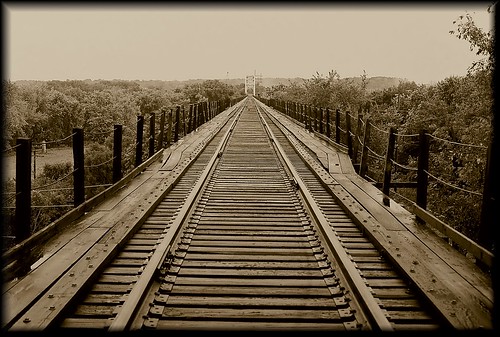As of yet though, there is no one-stop shop for recreation in the corridor. Why not leverage LaSalle-Peru's assets and create an urban recreational area? Recreation enjoys drama. The dramatic landscapes in LaSalle-Peru are the waterfront and the bluffs. The opportunities then are mainly along the Illinois River, the Steamboat Canal, and the edges of the three hills that LaSalle and Peru are built upon.
The following are possible facilities towards developing such a place:
Bicycling
The most promising for the area is bicycling. LaSalle is at the center of some old railroad grades and this creates the potential to assemble the old right of ways along the Illinois Central and LaSalle and Bureau County. The Kaskaskia Alliance Trail is hoping to secure trail rights along the Rock Island Line to link the I&M and Hennepin Canals -- This would make LaSalle-Peru the midway point on a state-spanning trail, which might hold good promise for us. The LS&BC could make a nice loop, going from LaSalle to Ladd and then looping down to Seatonville and hooking up with the Kaskaskia Alliance Trail. The Illinois Central could be extended to Troy Grove or even Mendota!
A dramatic opportunity would be to convert the old mile-long, Illinois Central Bridge into a bicycle path. Assembling the right of way of either the Illinois Central or the old CB&Q through Oglesby to Matthiessen Park would be a great linkage for LaSalle to have. At Matthiessen Park, there are mountain bicycling trails. Once across the Illinois and the Big Vermilion, it should be easy to extend a path to Starved Rock! This would create a great niche for LPO to have a safe pedestrian connection to these popular State Parks. The trail could later be extended to Tonica or even Streator!
 |
| Illinois Central Rail Bridge - LaSalle |
 |
| Rail Bridge converted to bicycle use near Jim Thorpe, PA |
What might the future of bicycle tourism look like in LaSalle? A small bicycle tourism company starts up renting bicycles to folks staying at bed and breakfasts in the downtown. This appeals to environmentally conscious tourists who really would like to experience the area at a human speed. One-stop-recreation-shop = Park and then everything is within a short ride. The company also provides guided tours to Matthiessen State Park, Starved Rock, Utica, a coal mining themed tour stopping at LaSalle, Ladd, Seatonville, and Spring Valley, a zinc industry themed tour stopping at LaSalle, Peru, and DePue. They also provide multi-day tours up the I&M Canal and the Hennepin Canal. They sponsor a week long bicycle ride from Chicago to the Mississippi that features a prominent stop in LaSalle.
Camping
At the end of the Illinois and Michigan Canal, LaSalle currently lacks the facilities to handle bicyclists. There is nowhere really to stay within an easy bike ride of the canal terminus. Providing a small camp ground, simply with a bathroom, perhaps a showers, perhaps atop the old road grade north of Lock 14. Another thought is that tiny cabins made to look like canal era structures could be provided with directions to a nearby key-holder.
Boating
There once was a proposal to construct a Marina just north of Shippingsport. This does not strike me as ideal, since it is so far away from town that it would generate relatively little activity or benefit to the town. More ideal would be to repurpose the old Steamboat Canal and Canal Basin as a marina. This would create activity right next to downtown and reinforce a historical theme. Another opportunity would be to water the canal at least to Utica at a depth usable to kayaks.
What might the future of boating look like in LaSalle? Chicagoans come down for the weekend to use their boat kept on a piece of the historic Illinois and Michigan Canal. The modern boats help illustrate the water activity that this place once held. There is a small launch coming down the west side of the canal basin. Kayaks are for rent for taking day trips from LaSalle to Utica. After a day of hard boating, Chicagoans eat a LaSalle's fine restaurants and shop for necessities downtown. Boating tourists come up the river, dock at LaSalle, restock their supplies, and check out the historic sites. There is even the revival of a siteseeing boat that travels to Starved Rock, just like one that existed a hundred years ago.
Zip-Lining
What bluff locations could be utilized for ziplining? Probably the most intriguing, though certainly a challenge, would be to zipline across the Illinois River. Perhaps this could be done from the end of West Street in Peru down to the other side of the river? The major challenge would be to get around (or move the) power lines.
Rock Climbing
 Perhaps a vertical sports center could be established at Westclox, in the part of the building overlooking the bluff. This could as high as six stories of your typical rock climbing wall material. This space would have an absolutely astounding view of the Valley.
Perhaps a vertical sports center could be established at Westclox, in the part of the building overlooking the bluff. This could as high as six stories of your typical rock climbing wall material. This space would have an absolutely astounding view of the Valley. Paintball
Everybody loves paintballing in old industrial areas. Perhaps a paintball area could be set up around some of the towns abandoned industries?
These are just a handful of ideas that would help develop the area as a place where you could come and spend a day exploring.











